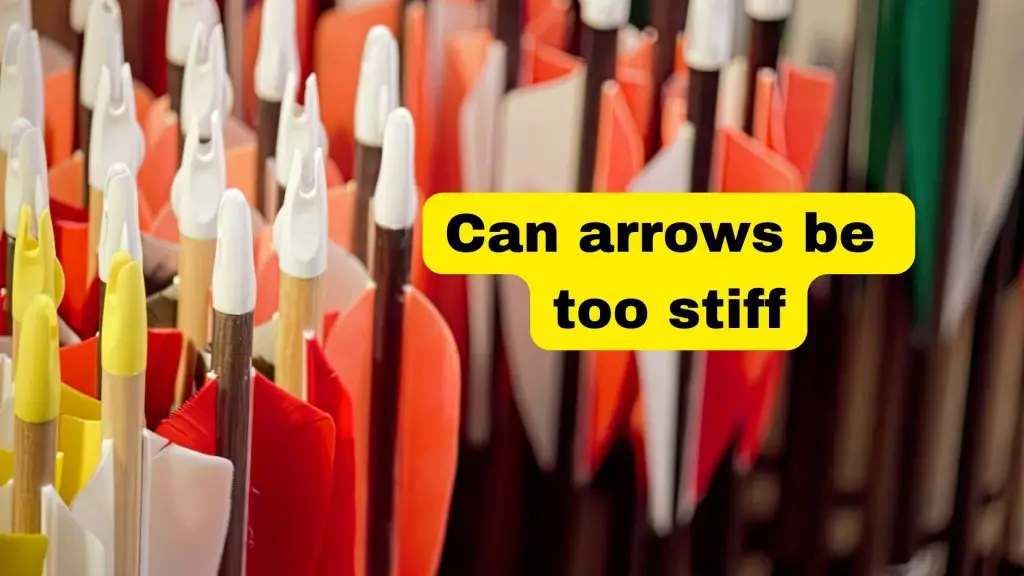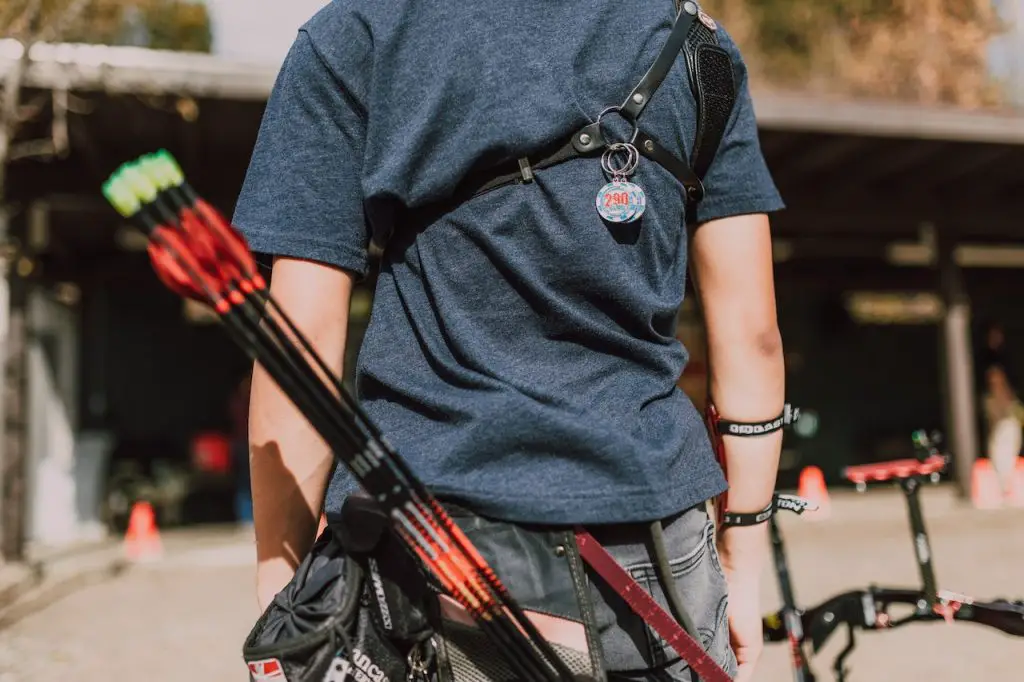Can an Arrow Be Too Stiff?
When it comes to archery, the equipment you use is crucial to your success. One of the most important components of your archery equipment is your arrows.
Arrows come in various stiffness levels, and it’s essential to choose the right stiffness for your bow’s draw weight and your shooting style.
However, can an arrow be too stiff?
we have already learnt about an arrows spin, now we will see about their stiffness
In this article, we will explore this question and provide you with the information you need to choose the right stiffness level for your arrows.

What Does Arrow Stiffness Mean?
Before we delve into whether an arrow can be too stiff, let’s first understand what arrow stiffness means.
Arrow stiffness, also known as spine, refers to the arrow’s ability to resist bending.
The spine of an arrow is determined by its material, length, and diameter, as well as the bow’s draw weight and the archer’s draw length. The stiffer the arrow, the less it will bend upon release.
Can an Arrow Be Too Stiff?
Yes, an arrow can be too stiff. When you shoot an arrow that is too stiff for your bow’s draw weight or your shooting style, it will not bend enough upon release.
This lack of bending can cause the arrow to fly incorrectly, resulting in poor accuracy and inconsistent arrow flight.
If your arrow is too stiff, it may also cause other problems such as decreased arrow speed and increased noise upon release.
This is because the arrow is not bending enough to transfer energy efficiently from the bow to the arrow, resulting in a loss of momentum.
Quick Answer, Yes an arrow can be too stiff. The stiffness of the arrow needs to be matched to the bow’s draw weight and the shooter’s draw length for optimal performance. If the arrow is too stiff, it will not flex enough when shot, resulting in erratic arrow flight, poor accuracy, and reduced velocity. On the other hand, if the arrow is too weak, it will flex too much, resulting in a loss of energy and reduced accuracy.
In the next section, we will discuss how to determine the appropriate arrow stiffness for your setup.
How to Determine if an Arrow is Too Stiff
It is essential to select the right arrow spine for your bow and shooting style to ensure accuracy, safety, and optimal performance. Here are some ways to determine if your arrow is too stiff:
A. Paper tuning
Paper tuning is a simple test that helps to determine the accuracy of an arrow. It involves shooting an arrow through a piece of paper and examining the resulting hole.
If the hole is round and even, the arrow is likely to have the correct spine. However, if the hole is angled or shows signs of tearing, the arrow may be too stiff or too weak.
Check: Walk-Back Tuning Vs. Paper Tuning: Which Is The Best?
B. Spine charts
Spine charts are available from most arrow manufacturers and can be a helpful tool in selecting the correct arrow spine for your bow.
Use of a spine chart-One of the easiest ways to determine the right arrow stiffness is to use a spine chart.
A spine chart is a tool that helps you match the stiffness of your arrow to the draw weight of your bow.
To use a spine chart, you will need to know the draw weight of your bow and the length of your arrow. Once you have this information, you can use the chart to determine the right spine stiffness for your arrow.
Manufacturers use two commonly recognized standards to assess an arrow’s spine rating: the Archery Trade Association (ATA) and the American Society for Testing and Materials (ASTM). Both organizations have established tests that determine the spine rating of an arrow, and they are similar in nature.
Resources:
https://www.infocusarchery.com/advice/a-completeish-guide-to-arrow-spine, https://www.ashbybowhunting.org/arrow-spine-calculator https://kustomkingarchery.com/pages/arrow-spine-chart
C. Seek advice from a professional
If you are unsure about the appropriate arrow spine for your bow, it is best to seek advice from a professional archery shop or coach.
They can help you select the right arrow spine based on your shooting style, bow setup, and other factors.
C. Testing of different arrow spines
If you are still unsure about the right arrow stiffness, you can test different arrow spines to see which one works best for you.
This can be done by shooting different arrow spines and measuring the accuracy and consistency of your shots. You can do this by recording a video of its flight.
By observing the flight of the arrow, you can tell if it’s veering to the left, indicating that the arrow is too stiff, or to the right, indicating that the arrow is too weak.
Once you have identified the issue, you can take appropriate steps to adjust the arrow’s stiffness, such as changing the arrow spine or point weight.
You can also work with an archery pro to help you with this testing.

Risks and Dangers of Using an Arrow That is Too Stiff
When it comes to archery, using the right equipment is crucial for safety and accuracy.
One common question among archers is whether an arrow can be too stiff. The answer is yes, and using an arrow that is too stiff can pose several risks and dangers.
A. Inaccuracy
Using an arrow that is too stiff can significantly impact accuracy.
An arrow that is too stiff will resist bending or flexing when shot from the bow, resulting in erratic arrow flight and poor grouping.
This can make it challenging to hit a target consistently and increase the chances of missing the target altogether.
B. Injury to the shooter
An arrow that is too stiff can also cause injury to the shooter.
The stiff arrow can cause the bowstring to slap back at the shooter, resulting in a painful sting or, in some cases, a serious injury.
This is because the arrow is not flexing or bending enough upon release, causing the bow to absorb the energy and sending it back towards the shooter.
Check: What Is String Plucking In Archery?
Are Chest Guards Important in Archery?
C. Damage to equipment
Using an arrow that is too stiff can also cause damage to the bow and other equipment.
The excessive energy that the bow has to absorb upon release can lead to damage to the limbs, strings, and even the bow itself.
Over time, this can lead to significant wear and tear, resulting in costly repairs or replacements.
Factors that Affect Arrow Stiffness
The stiffness of an arrow is not just determined by the arrow itself but also by several external factors. Here are the primary factors that can affect arrow stiffness:
A. Arrow Length
The length of an arrow affects its stiffness. Shorter arrows are stiffer than longer ones. For instance, if two arrows have the same diameter and spine rating, the shorter arrow will be stiffer. This is because the shorter arrow has less material, which makes it harder to bend.
B. Bow Draw Weight
The draw weight of your bow also affects the stiffness of your arrow. The higher the draw weight, the stiffer the arrow needs to be to perform properly. For instance, if you shoot a 70-pound bow, you will need a stiffer arrow than if you shoot a 50-pound bow.
C. Arrow Point Weight
The weight of your arrow point affects the stiffness of your arrow. Heavier arrow points make the arrow stiffer. This is because a heavier point causes the arrow to flex less, which in turn requires a stiffer arrow to achieve optimal performance.
D. Arrow Material
The material of your arrow also affects its stiffness. Different materials have different stiffness ratings. For instance, carbon arrows are stiffer than aluminum arrows of the same diameter and spine rating.
How to Determine the Right Arrow Stiffness
Determining the right arrow stiffness for your setup requires taking into consideration the above factors.
The goal is to find an arrow that is neither too stiff nor too weak for your bow setup. The best way to determine the right arrow stiffness is to consult an archery professional.
Another way to determine the right arrow stiffness is to use an arrow spine chart. An arrow spine chart is a tool that matches your bow’s draw weight, arrow length, and arrow point weight to the correct arrow stiffness.
Can Arrow Spine be Adjusted?
Yes, arrow spine can be adjusted to some extent. The spine of an arrow is determined by its stiffness, which is influenced by various factors, including the arrow’s length, weight, and material. Here are some ways to adjust arrow spine:
- Change the point weight: Increasing or decreasing the weight of the arrow point can help to adjust the arrow spine. A heavier point can make the arrow more flexible or weaker, while a lighter point can make the arrow stiffer.
- Cut the arrow shaft: Shortening the arrow shaft can make it stiffer, while lengthening it can make it more flexible or weaker.
- Change the arrow material: Different arrow materials have different stiffness properties, and switching to a different material can help to adjust the arrow spine.
It is important to note that while some adjustments can be made to an arrow’s spine, there are limits to how much it can be adjusted. It is best to consult a professional archery shop or coach for advice on how to properly adjust arrow spine.
How to check your arrow stiffness is perfect?
To check if your arrow stiffness is perfect, you need to ensure that they’re flying well and striking the target where you want them to.
Here are the steps to follow:
- Shoot a few arrows and observe their flight. If the arrows are flying straight and true, without wobbling or veering off course, then they may have the correct stiffness.
- Check if the arrows are hitting the target where you want them to. If the arrows are consistently hitting the same spot, then it’s an indication that the arrow stiffness is good.
- Conduct a bare shaft or paper test to confirm that the arrows have the correct spine. If the arrows pass the test, then they’re likely to have the right stiffness.
- Remember that ultimately, only hitting the target counts. If the arrows are consistently hitting the target where you want them to, then their stiffness is perfect for your bow and shooting style.
It’s also important to note that arrow stiffness is not the only factor that affects accuracy.
sometimes, Other factors such as bow setup, arrow weight, and shooting form can also influence arrow performance. Therefore, it’s essential to work with a professional archery shop or coach to optimize your equipment and shooting technique.
Conclusion
In conclusion, choosing the right arrow stiffness is crucial for the accuracy, safety, and overall success of your archery shooting.
An arrow that is too stiff can lead to inaccuracy, injury to the shooter, and damage to the equipment. On the other hand, an arrow that is too weak can also cause problems such as increased arrow drag and decreased penetration power.
Factors that affect arrow stiffness include arrow length, bow draw weight, arrow point weight, and arrow material. It is important to consider all of these factors when choosing the right arrow stiffness for your bow.
There are several ways to determine the right arrow stiffness, including using a spine chart, consulting with an archery pro, and testing different arrow spines. Using a spine chart is a great starting point, but it is important to remember that it is not an exact science and may require some trial and error.
With the right arrow stiffness, you can improve your accuracy, increase your penetration power, and ensure the safety of yourself and others around you.

